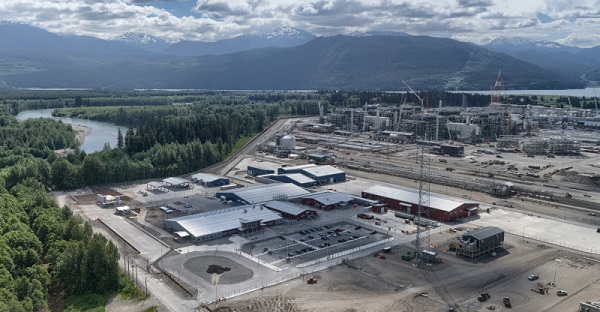Energy
Energy policies proposed at Republican and Democrat conventions are worlds apart

 From the Daily Caller News Foundation
From the Daily Caller News Foundation
Democrats Are On A Different Planet
As Republicans and Democrats meet at the conventions and propose policies for the next four years, the contrast between Republican and Democrat energy policies could not be greater.
Republicans would speed up oil and natural gas production; eliminate mandates to purchase electric vehicles; get rid of subsidies for renewables; and end dependence on China. Democrats propose to electrify the energy supply, ridding the economy of gasoline-powered vehicles and natural-gas appliances and substituting solar and wind for legacy fuels.
Through a series of executive orders and regulations, President Joe Biden has reduced federal oil and gas leases. America has 373.1 billion barrels of technically recoverable crude oil resources, and 2,973 trillion cubic feet of technically recoverable natural gas resources — an 85-year supply. Expect the next Republican administration to encourage production and use these resources to lower energy prices at home and around the world.
A Republican president would be able to reverse Biden’s executive orders and regulations. Increasing energy production is fourth out of 20 promises in the 2024 Republican Platform, “We will DRILL, BABY, DRILL and we will become Energy Independent, and even Dominant again. The United States has more liquid gold under our feet than any other Nation, and it’s not even close. The Republican Party will harness that potential to power our future.”
A Republican administration would allow a choice in cars. The Republican Party Platform calls for cancelling the mandate for EVs.
The Biden administration is subsidizing electric vehicles through the Inflation Reduction Act. Companies are paid to manufacture these EVs and consumers get tax credits to buy them. The Environmental Protection Agency’s final tailpipe rule would require 70% of new cars sold and 25% or new trucks sold to be battery powered electric or plug-in hybrid by 2032.
The Biden administration has focused on providing wind and solar power through billions in tax credits in the Infrastructure and Jobs Act and the Inflation Reduction Act. Either directly or through access to banks and Wall Street investors, it is deciding who is suitable to receive funding for energy projects.
But government control of energy is control of people and the economy. This is one reason why the trend toward nationalization of our energy industry through government mandates, bans on the production and use of oil and natural gas and reorganization of the electric grid is so dangerous.
Under a new Republican administration, rather than slowing down pipeline approval, the Federal Energy Regulatory Commission would focus on speeding it up. The Bureau of Land Management would prioritize approving both onshore and offshore drilling permits. The Security and Exchange Commission would no longer look at climate effects of companies’ investments, and the Office of the Comptroller of the Currency would not look at the climate effects of bank loans.
Democrat energy policies increase dependence on China because China makes nearly 80% of the world’s batteries and is home to 7 out of 10 of the world’s largest solar panel manufacturers, and 7 out of 10 of the world’s largest wind turbine manufacturers. China dominates the critical minerals such as lithium and cobalt required for EVs through its own mines and by purchasing mines in Africa and Latin America.
Trade with China is not free or fair. China can produce lower-cost goods because it subsidizes labor, capital and energy. It uses forced labor from Xinjiang; gives low-interest rate loans to favored companies; and is not bound by the clean energy regulations of the West.
The next administration should use America’s domestic resources and provide tools to assist our allies and deter our adversaries.
Diana Furchtgott-Roth, former deputy assistant secretary for research and technology at the U.S. Department of Transportation, is the director of The Heritage Foundation’s Center for Energy, Climate and Environment.
Alberta
Temporary Alberta grid limit unlikely to dampen data centre investment, analyst says
From the Canadian Energy Centre
By Cody Ciona
‘Alberta has never seen this level and volume of load connection requests’
Billions of investment in new data centres is still expected in Alberta despite the province’s electric system operator placing a temporary limit on new large-load grid connections, said Carson Kearl, lead data centre analyst for Enverus Intelligence Research.
Kearl cited NVIDIA CEO Jensen Huang’s estimate from earlier this year that building a one-gigawatt data centre costs between US$60 billion and US$80 billion.
That implies the Alberta Electric System Operator (AESO)’s 1.2 gigawatt temporary limit would still allow for up to C$130 billion of investment.
“It’s got the potential to be extremely impactful to the Alberta power sector and economy,” Kearl said.
Importantly, data centre operators can potentially get around the temporary limit by ‘bringing their own power’ rather than drawing electricity from the existing grid.
In Alberta’s deregulated electricity market – the only one in Canada – large energy consumers like data centres can build the power supply they need by entering project agreements directly with electricity producers.
According to the AESO, there are 30 proposed data centre projects across the province.
The total requested power load for these projects is more than 16 gigawatts, roughly four gigawatts more than Alberta’s demand record in January 2024 during a severe cold snap.
For comparison, Edmonton’s load is around 1.4 gigawatts, the AESO said.
“Alberta has never seen this level and volume of load connection requests,” CEO Aaron Engen said in a statement.
“Because connecting all large loads seeking access would impair grid reliability, we established a limit that preserves system integrity while enabling timely data centre development in Alberta.”
As data centre projects come to the province, so do jobs and other economic benefits.
“You have all of the construction staff associated; electricians, engineers, plumbers, and HVAC people for all the cooling tech that are continuously working on a multi-year time horizon. In the construction phase there’s a lot of spend, and that is just generally good for the ecosystem,” said Kearl.
Investment in local power infrastructure also has long-term job implications for maintenance and upgrades, he said.
“Alberta is a really exciting place when it comes to building data centers,” said Beacon AI CEO Josh Schertzer on a recent ARC Energy Ideas podcast.
“It has really great access to natural gas, it does have some excess grid capacity that can be used in the short term, it’s got a great workforce, and it’s very business-friendly.”
The unaltered reproduction of this content is free of charge with attribution to the Canadian Energy Centre.
Energy
LNG Export Marks Beginning Of Canadian Energy Independence

From the Frontier Centre for Public Policy
Kitimat’s LNG launch ends years of delay, weak policy and lost opportunity. This is a strategic turning point for Canada
Last week marked a turning point for Canadian sovereignty. On July 1, 2025, the tanker Gaslog Glasgow departed Kitimat, B.C., carrying Canada’s first-ever commercial liquefied natural gas (LNG) export to Asia. More than a shipment, it signalled the end of our economic vassalage to the United States and a long-overdue leap into global energy markets.
LNG Canada CEO Chris Cooper called it a “truly historic moment.” He’s right. The cargo left just days after the Kitimat plant produced its first liquefied natural gas and entered operation. The $40-billion megaproject, the largest private-sector investment in Canadian history, is now a fully functional Pacific Coast export hub. It can ship up to 14 million tonnes annually, and expansion is already being discussed.
Yet this success didn’t come easily. Despite being one of the world’s largest natural gas producers, Canada lacked an LNG export terminal, largely due to political delays, regulatory hurdles and lack of federal support. That this happened at all is remarkable, given nearly a decade of federal sabotage. Prime Minister Justin Trudeau’s ideological hostility to natural gas meant rebuffed allies, stalled projects and choked-off investment.
Foreign leaders (from Japan and Germany to Greece) practically begged Ottawa to green-light Canadian LNG. Trudeau dismissed them, claiming there was “no business case.” No one in his caucus dared contradict him. The result: lost time, lost markets and a near-complete surrender of our energy advantage.
But the business case was always there. Kitimat proves it.
The U.S. has been exporting LNG since 2016, giving them a nearly decade-long head start. But Canada has something our neighbours don’t: the Montney Formation. Spanning northeast B.C. and parts of Alberta, it covers about 130,000 square kilometres and holds enormous gas reserves. Montney gas, abundant and close to tidewater, trades at roughly half the Henry Hub price, giving Canada a significant cost edge.
Location seals the deal. Kitimat, perched on the Pacific, bypasses the congested Panama Canal, a major chokepoint for U.S. Gulf Coast exports, and offers a shorter, more direct route to energy-hungry Asian markets. This geographic advantage makes Canadian LNG not only viable but globally competitive.
In 2024, Canada exported about 8.6 billion cubic feet of gas daily to the U.S. via pipeline. With Kitimat, we finally begin breaking that one-market dependency. We also start clawing back the price differential losses that come with being captive sellers. This is how you build productivity, strengthen the dollar and reclaim economic independence from Washington.
The economic ripple effect is massive. The Kitimat build created 50,000 jobs at its peak, generated $5.8 billion in Indigenous and local contracts and left behind more than 300 permanent positions. Provincial revenues are projected in the tens of billions. In an era of anaemic growth, this is real stimulus and has staying power.
Predictably, critics raise environmental concerns. But this critique ignores global realities. Exporting Canadian natural gas to countries still burning coal is not a step backward—it’s a practical advance. Natural gas is up to 25 per cent cleaner than coal when comparing full lifecycle emissions (that is, from extraction to combustion). Global emissions don’t respect borders. If Canada can displace dirtier fuels abroad, we’re part of the solution, not the problem.
And this is only the beginning. Cedar LNG and Woodfibre LNG are already under construction. Atlantic Coast projects are in the queue. We must now defend this momentum against bureaucratic delays, activist litigation and ideological roadblocks.
LNG is not a climate villain. It’s a bridge fuel that cuts emissions, creates wealth and helps fund our national future.
Marco Navarro-Genie is vice-president of research at the Frontier Centre for Public Policy and co-author, with Barry Cooper, of Canada’s COVID: The Story of a Pandemic Moral Panic (2023).
-

 illegal immigration2 days ago
illegal immigration2 days agoICE raids California pot farm, uncovers illegal aliens and child labor
-

 Uncategorized13 hours ago
Uncategorized13 hours agoCNN’s Shock Climate Polling Data Reinforces Trump’s Energy Agenda
-

 Opinion6 hours ago
Opinion6 hours agoPreston Manning: Three Wise Men from the East, Again
-

 Addictions6 hours ago
Addictions6 hours agoWhy B.C.’s new witnessed dosing guidelines are built to fail
-

 Business3 hours ago
Business3 hours agoCarney Liberals quietly award Pfizer, Moderna nearly $400 million for new COVID shot contracts
-

 Business1 day ago
Business1 day agoTrump to impose 30% tariff on EU, Mexico
-

 Energy1 day ago
Energy1 day agoLNG Export Marks Beginning Of Canadian Energy Independence
-

 Business1 day ago
Business1 day agoCarney government should apply lessons from 1990s in spending review






